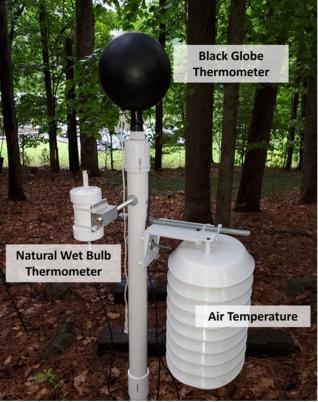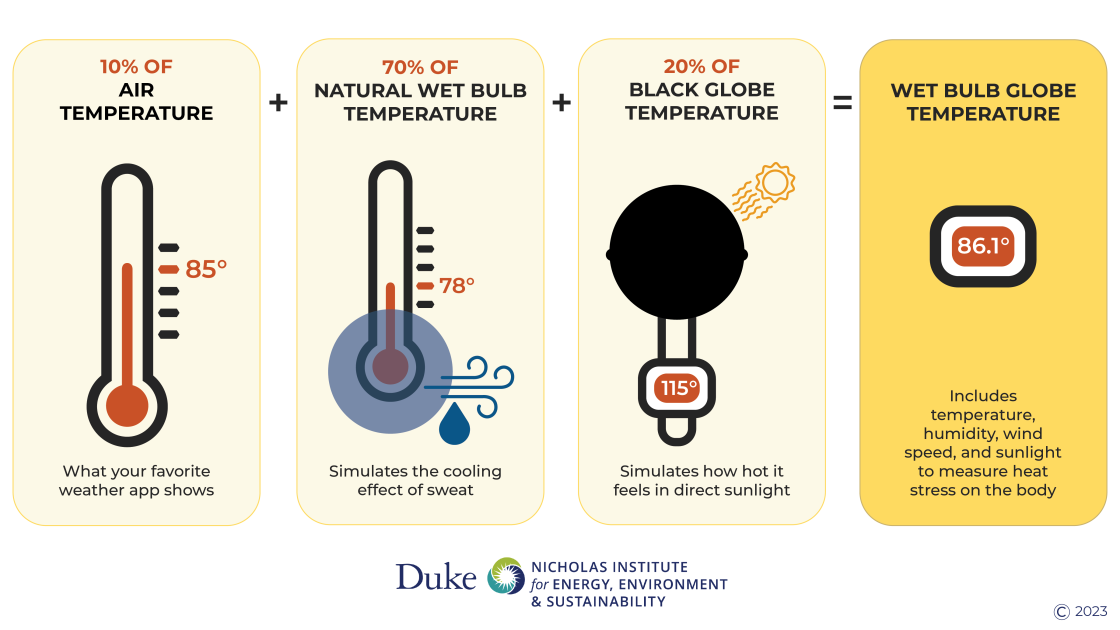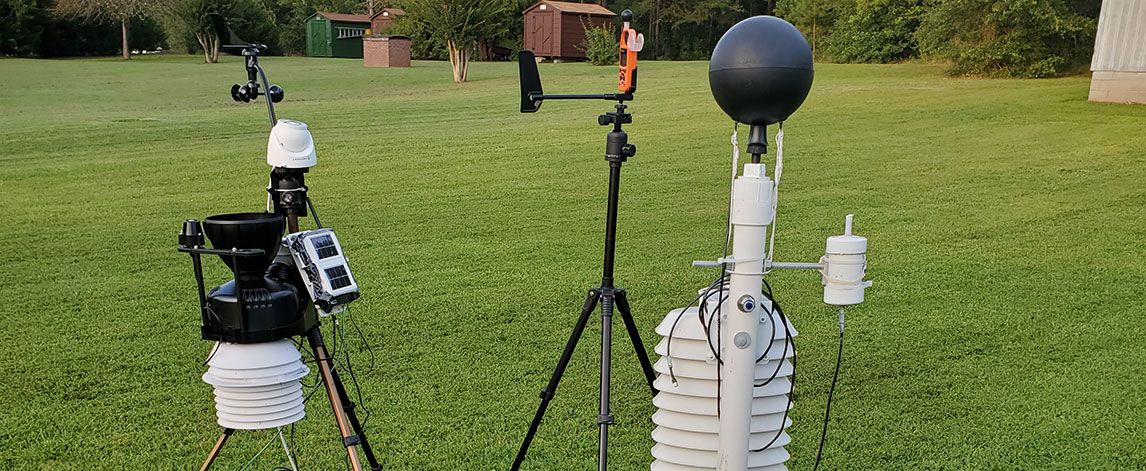Many factors in the environment have an impact on our body temperature:
- Air temperature and sunlight affect our skin temperature.
- Humidity affects sweating and cooling.
- Wind speed can blow away heat from our bodies and helps sweat evaporate which cools us down.
To determine how much stress heat is putting on our bodies, scientists combine all these factors together into one measurement. Two of the most common “feels like temperatures” are the Heat Index and Wet Bulb Globe Temperature.
Heat Index
The Heat Index is often referred to as the “feels like” temperature. It estimates how hot the conditions “feel” to our bodies when we consider humidity along with air temperature. In humid places, the Heat Index is a better indicator of heat stress than the air temperature, but it only addresses what conditions are like in the shade. This is a major limitation since many outdoor activities and work do not occur in the shade. The Heat index also doesn’t account for wind speed and how that cools our bodies down. These issues can be addressed by using a different measurement, such as wet bulb globe temperature (WBGT).
Wet Bulb Globe Temperature (WBGT)

WBGT tells us how hot it is based on the (1) temperature, (2) humidity, (3) wind speed, and (4) sunlight. It was developed by the US military in the 1950s to prevent heat-related deaths in training camps. Today it is used in some workplaces and for some sports, such as high school football in a few US states.
WBGT is a combination of three measurements:
- Air temperature is measured by a typical outdoor thermometer.
- Natural wet bulb temperature is measured by a thermometer wrapped in a wet cloth, which simulates the cooling effect of sweat (which is influenced largely by wind and humidity). Since the thermometer is exposed to the sun, it also accounts for the effects of sunlight.
- Black globe temperature is measured with a thermometer inside a black globe, which indicates how hot it feels in direct sunlight.
To figure out WBGT, scientists combine the measurements with this equation:
WBGT = 10% of the air temperature + 70% of the natural wet bulb temperature + 20% of the black globe temperature

For example, if the air temperature is 85°F, the natural wet bulb temperature is 78°F, and the black globe temperature is 115°F, the WBGT is 86.1°F.
The equation for this would be:
WBGT = (10% of 85°F = 8.5°F) + (70% of 78°F = 54.6°F) + (20% of 115°F = 23°F) = 86.1°F
How does WBGT inform what actions we should take?
The WBGT values that are considered dangerous are different based on who you are (such as your age) and the type of activity you are doing (such as walking or running). Typically, any WBGT above 90 degrees is in the most dangerous category for heat stress on our health. Depending on where the WBGT falls between 80 and 90 degrees, there are big differences in the actions we would need to take to protect against heat stress.
WBGT is often communicated as a flag color, as you can see in this chart based on guidance for North Carolina high school football athletes from the U.S. National Weather Service and the North Carolina High School Athletics Association.
For our example of a WBGT of 86°F, the flag would be Yellow. This would require certain changes to football practice (intensity, clothing, and water/rest breaks) as shown in this table.
| WBGT (°F) | Athletic Activity Guidelines |
|---|---|
| Less than 80 | Unlimited activity with primary cautions for new or unconditioned athletes or extreme exertion; schedule mandatory rest/water breaks (5 min water/rest break every 30 min). |
| 80 - 84.9 | Normal practice for athletes; closely monitor new or unconditioned athletes and all athletes during extreme exertion. Schedule mandatory rest/water breaks (5 min water/rest break every 25 min). |
| 85 - 87.9 | New or unconditioned athletes should have reduced intensity practice and modifications in clothing. Well-conditioned athletes should have more frequent rest breaks and hydration as well as cautious monitoring for symptoms of heat illness. Schedule frequent mandatory rest/water breaks (5 min water/rest break every 20 min). Have cold or ice immersion pool on site for practice. |
| 88 - 89.9 | All athletes must be under constant observation and supervision. Remove pads and equipment. Schedule frequent mandatory rest/water breaks (5 min water/rest break every 15 min). Have cold or ice immersion pool on site for practice. |
| 90+ | SUSPEND PRACTICE/MUST INCLUDE MANDATORY BREAKS AS DIRECTED BY GAMEDAY ADMINISTRATION DURING CONTEST. |
Why use WBGT rather than the Heat Index?
WBGT is better than the Heat Index at showing if conditions are dangerous. Check out this comparison of weather conditions on two days. Although the air temperature of 85° F on the second day is ten degrees cooler than the temperature on the first day, (1) the humidity is higher and (2) the wind is slower. This means that the WBGT on the second day is higher than on the first day, while the Heat Index is cooler.
| Temperature | Humidity | Wind | WBGT | Heat Index | |
|---|---|---|---|---|---|
| Day 1 | 95° | 25% | 4 mph | 85.3° (yellow flag) | 93° |
| Day 2 | 85° | 50% | 2 mph | 88.1° (red flag) | 86° |
WBGT is a powerful way to calculate how hot the environment is. The most common way of measuring WBGT is with handheld meters. Factors like wind and humidity vary a lot across small distances (so what is measured a mile away could be several degrees different from where you are). When using WBGT to determine if outdoor activity is safe, it is critical that accurate measurements of WBGT be recorded at the site of activity.
Additional resources
Heat Hazard Recognition from the US Occupational Safety & Health Administration
WBGT forecast tool (Convergence of Climate-Health Vulnerabilities at UNC)
WBGT national forecast (National Weather Service)

